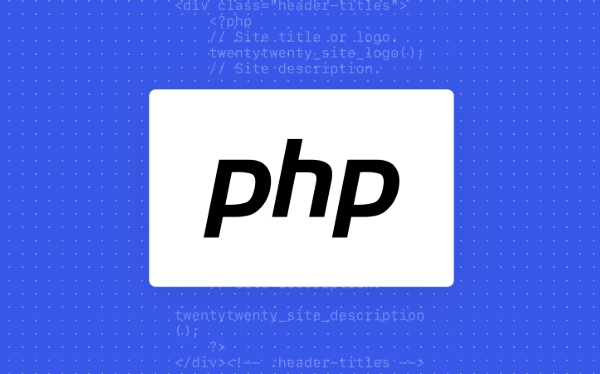Building Resilient Microservices with PHP and RabbitMQ
Jul 27, 2025 am 04:32 AMTo build a flexible PHP microservice, you need to use RabbitMQ to achieve asynchronous communication. 1. Decouple the service through message queues to avoid cascade failures; 2. Configure persistent queues, persistent messages, publish confirmation and manual ACK to ensure reliability; 3. Use exponential backoff retry, TTL and dead letter queue security processing failures; 4. Use tools such as supervisord to protect consumer processes and enable heartbeat mechanisms to ensure service health; and ultimately realize the ability of the system to continuously operate in failures.

Building resilient microservices isn't just about writing clean code — it's about designing systems that can withstand failures, scale independently, and communicate reliable. When using PHP in a microservices architecture, one of the biggest challenges is managing inter-service communication without introducing tight coupling or downtime. That's where RabbitMQ comes in.

RabbitMQ, a robust message broker, enables asynchronous communication between services, decoupling producers from consumers and allowing systems to gracefully handle load spikes, temporary outages, and processing delays. Combined with PHP — a language widely used for web services despite its stateless nature — RabbitMQ helps build microservices that are not only scalable but also fault-tolerant.
Here's how to use PHP and RabbitMQ effectively to build truly resilient microservices.

1. Decouple Services with Asynchronous Messaging
In a typical synchronous setup (eg, REST API calls), Service A must wait for Service B to respond. If Service B is down or slow, Service A may time out or degrade in performance — creating a cascade of failures.
By introducing RabbitMQ, you replace direct HTTP calls with message queues:

- Service A publishes a message (eg, “UserRegistered”) to a queue.
- Service B consumes the message when it's ready — even if it was offline during publishing.
This approach ensures that:
- Services don't depend on each other's availability.
- Temporary failures in one service don't block others.
- Work can be retired or delayed without losing data.
Example use case : After a user signs up, instead of calling the email service directly, your auth service publishes an event like:
$channel->basic_publish(
new AMQPMessage(json_encode([
'event' => 'user_registered',
'user_id' => 123,
'email' => 'user@example.com'
])),
'', 'user_events'
);The email service picks this up later and sends the welcome email — even if it was restarting at the time.
2. Ensure Message Durability and Reliability
To make your system resilient, you need to guarantee that messages aren't lost, even if RabbitMQ restarts or crashes.
Here's what you should configure:
- Persistent queues : Declare queues as durable so they survive broker restarts.
- Persistent messages : Mark messages as persistent so they're written to disk.
- Publisher confirms : Enable confirm mode to ensure messages are actually received by RabbitMQ.
- Consumer acknowledgments : Use manual ACKs so messages are only removed after successful processing.
PHP setup example :
// Declare durable queue
$channel->queue_declare('user_events', false, true, false, false);
// Publish persistent message
$message = new AMQPMessage($payload, ['delivery_mode' => 2]); // 2 = persistent
$channel->basic_publish($message, '', 'user_events');
// Enable publisher confirms
$channel->confirm_select();
// Consumer with manual ACK
$channel->basic_consume('user_events', '', false, false, false, false, function ($msg) use ($channel) {
try {
processMessage($msg->body);
$channel->basic_ack($msg->getDeliveryTag()); // ACK only after success
} catch (\Exception $e) {
// Reject and optionally request
$channel->basic_nack($msg->getDeliveryTag(), false, true);
}
});Without these settings, a crashed broker could wipe out pending messages — breaking resilience.
3. Handle Failures Gracefully with Retry Mechanisms and Dead Letter Queues
Even with durable messaging, some messages will fail — due to bugs, network issues, or transient errors. Blindly retrying forever isn't safe.
Use this strategy:
- Retry with exponential backoff : Requeue failed messages with increasing delays.
- Limit retry attempts : Prevent infinite loops.
- Dead Letter Exchange (DLX) : Move messages that fail repeatedly to a separate queue for inspection.
Implementation idea :
Set up a queue with a TTL (time-to-live) and a dead-letter exchange:
$args = new AMQPTable([
'x-dead-letter-exchange' => 'dlx',
'x-message-ttl' => 60000, // Retry for 60 seconds
]);
$channel->queue_declare('user_events', false, true, false, false, false, false, $args);When a message fails processing and is rejected with request, you can delay it using a TTL-based retry queue, then eventually send it to the DLX for logging or manual intervention.
This prevents lost messages and give you visibility into persistent failures.
4. Monitor and Maintain Health with Heartbeats and Supervision
PHP processes are typically short-lived (CLI scripts or workers), so long-running consumers can crash silently.
Best practices:
- Run consumers as long-lived CLI daemons (using
supervisordorsystemd). - Enable heartbeats in RabbitMQ connections to detect dead consumers.
- Log message processing and monitor queue lengths.
Supervisor config example ( supervisord.conf ):
[program:email_consumer] command=php consume_emails.php numprocs=1 autostart=true autorestart=true stderr_logfile=/var/log/email-consumer.err.log stdout_logfile=/var/log/email-consumer.out.log
This ensures your consumer restarts automatically if it crashes — a small but critical part of resilience.
Final Thoughts
Resilience in microservices isn't achieved in one step. With PHP and RabbitMQ, you get a powerful combination — PHP for rapid development and RabbitMQ for reliable messaging.
Key takeaways:
- Use RabbitMQ to decouple services and avoid cascading failures.
- Make queues and messages durable to survive outages.
- Implement retry logic and DLX to handle errors safely.
- Supervise consumers to keep them alive and responsive.
With these patterns, your PHP-based microservices can handle real-world chaos — from deployment hiccups to suddenly traffic surges — without breaking a sweat.
Basically, it's not about preventing all failures (that's impossible), but about designing a system that keeps working despite them.
The above is the detailed content of Building Resilient Microservices with PHP and RabbitMQ. For more information, please follow other related articles on the PHP Chinese website!

Hot AI Tools

Undress AI Tool
Undress images for free

Undresser.AI Undress
AI-powered app for creating realistic nude photos

AI Clothes Remover
Online AI tool for removing clothes from photos.

Clothoff.io
AI clothes remover

Video Face Swap
Swap faces in any video effortlessly with our completely free AI face swap tool!

Hot Article

Hot Tools

Notepad++7.3.1
Easy-to-use and free code editor

SublimeText3 Chinese version
Chinese version, very easy to use

Zend Studio 13.0.1
Powerful PHP integrated development environment

Dreamweaver CS6
Visual web development tools

SublimeText3 Mac version
God-level code editing software (SublimeText3)

Hot Topics
 How to use PHP to build social sharing functions PHP sharing interface integration practice
Jul 25, 2025 pm 08:51 PM
How to use PHP to build social sharing functions PHP sharing interface integration practice
Jul 25, 2025 pm 08:51 PM
The core method of building social sharing functions in PHP is to dynamically generate sharing links that meet the requirements of each platform. 1. First get the current page or specified URL and article information; 2. Use urlencode to encode the parameters; 3. Splice and generate sharing links according to the protocols of each platform; 4. Display links on the front end for users to click and share; 5. Dynamically generate OG tags on the page to optimize sharing content display; 6. Be sure to escape user input to prevent XSS attacks. This method does not require complex authentication, has low maintenance costs, and is suitable for most content sharing needs.
 How to use PHP combined with AI to achieve text error correction PHP syntax detection and optimization
Jul 25, 2025 pm 08:57 PM
How to use PHP combined with AI to achieve text error correction PHP syntax detection and optimization
Jul 25, 2025 pm 08:57 PM
To realize text error correction and syntax optimization with AI, you need to follow the following steps: 1. Select a suitable AI model or API, such as Baidu, Tencent API or open source NLP library; 2. Call the API through PHP's curl or Guzzle and process the return results; 3. Display error correction information in the application and allow users to choose whether to adopt it; 4. Use php-l and PHP_CodeSniffer for syntax detection and code optimization; 5. Continuously collect feedback and update the model or rules to improve the effect. When choosing AIAPI, focus on evaluating accuracy, response speed, price and support for PHP. Code optimization should follow PSR specifications, use cache reasonably, avoid circular queries, review code regularly, and use X
 PHP creates a blog comment system to monetize PHP comment review and anti-brush strategy
Jul 25, 2025 pm 08:27 PM
PHP creates a blog comment system to monetize PHP comment review and anti-brush strategy
Jul 25, 2025 pm 08:27 PM
1. Maximizing the commercial value of the comment system requires combining native advertising precise delivery, user paid value-added services (such as uploading pictures, top-up comments), influence incentive mechanism based on comment quality, and compliance anonymous data insight monetization; 2. The audit strategy should adopt a combination of pre-audit dynamic keyword filtering and user reporting mechanisms, supplemented by comment quality rating to achieve content hierarchical exposure; 3. Anti-brushing requires the construction of multi-layer defense: reCAPTCHAv3 sensorless verification, Honeypot honeypot field recognition robot, IP and timestamp frequency limit prevents watering, and content pattern recognition marks suspicious comments, and continuously iterate to deal with attacks.
 PHP calls AI intelligent voice assistant PHP voice interaction system construction
Jul 25, 2025 pm 08:45 PM
PHP calls AI intelligent voice assistant PHP voice interaction system construction
Jul 25, 2025 pm 08:45 PM
User voice input is captured and sent to the PHP backend through the MediaRecorder API of the front-end JavaScript; 2. PHP saves the audio as a temporary file and calls STTAPI (such as Google or Baidu voice recognition) to convert it into text; 3. PHP sends the text to an AI service (such as OpenAIGPT) to obtain intelligent reply; 4. PHP then calls TTSAPI (such as Baidu or Google voice synthesis) to convert the reply to a voice file; 5. PHP streams the voice file back to the front-end to play, completing interaction. The entire process is dominated by PHP to ensure seamless connection between all links.
 How to use PHP to combine AI to generate image. PHP automatically generates art works
Jul 25, 2025 pm 07:21 PM
How to use PHP to combine AI to generate image. PHP automatically generates art works
Jul 25, 2025 pm 07:21 PM
PHP does not directly perform AI image processing, but integrates through APIs, because it is good at web development rather than computing-intensive tasks. API integration can achieve professional division of labor, reduce costs, and improve efficiency; 2. Integrating key technologies include using Guzzle or cURL to send HTTP requests, JSON data encoding and decoding, API key security authentication, asynchronous queue processing time-consuming tasks, robust error handling and retry mechanism, image storage and display; 3. Common challenges include API cost out of control, uncontrollable generation results, poor user experience, security risks and difficult data management. The response strategies are setting user quotas and caches, providing propt guidance and multi-picture selection, asynchronous notifications and progress prompts, key environment variable storage and content audit, and cloud storage.
 PHP realizes commodity inventory management and monetization PHP inventory synchronization and alarm mechanism
Jul 25, 2025 pm 08:30 PM
PHP realizes commodity inventory management and monetization PHP inventory synchronization and alarm mechanism
Jul 25, 2025 pm 08:30 PM
PHP ensures inventory deduction atomicity through database transactions and FORUPDATE row locks to prevent high concurrent overselling; 2. Multi-platform inventory consistency depends on centralized management and event-driven synchronization, combining API/Webhook notifications and message queues to ensure reliable data transmission; 3. The alarm mechanism should set low inventory, zero/negative inventory, unsalable sales, replenishment cycles and abnormal fluctuations strategies in different scenarios, and select DingTalk, SMS or Email Responsible Persons according to the urgency, and the alarm information must be complete and clear to achieve business adaptation and rapid response.
 Beyond the LAMP Stack: PHP's Role in Modern Enterprise Architecture
Jul 27, 2025 am 04:31 AM
Beyond the LAMP Stack: PHP's Role in Modern Enterprise Architecture
Jul 27, 2025 am 04:31 AM
PHPisstillrelevantinmodernenterpriseenvironments.1.ModernPHP(7.xand8.x)offersperformancegains,stricttyping,JITcompilation,andmodernsyntax,makingitsuitableforlarge-scaleapplications.2.PHPintegrateseffectivelyinhybridarchitectures,servingasanAPIgateway
 How to use PHP to develop AI-driven advertising delivery PHP advertising performance optimization solution
Jul 25, 2025 pm 06:12 PM
How to use PHP to develop AI-driven advertising delivery PHP advertising performance optimization solution
Jul 25, 2025 pm 06:12 PM
PHP provides an input basis for AI models by collecting user data (such as browsing history, geographical location) and pre-processing; 2. Use curl or gRPC to connect with AI models to obtain click-through rate and conversion rate prediction results; 3. Dynamically adjust advertising display frequency, target population and other strategies based on predictions; 4. Test different advertising variants through A/B and record data, and combine statistical analysis to optimize the effect; 5. Use PHP to monitor traffic sources and user behaviors and integrate with third-party APIs such as GoogleAds to achieve automated delivery and continuous feedback optimization, ultimately improving CTR and CVR and reducing CPC, and fully implementing the closed loop of AI-driven advertising system.






